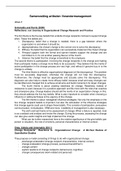Samenvatting artikelen Verandermanagement
Week 5
Armenakis and Harris (2009)
Reflections: our Journey in Organizational Change Research and Practice
The first theme is the five key beliefs that underlie change recipients motives to support change
effort. These five beliefs are:
1. Discrepancy: belief that a change is needed; there is a gap between where the
organization is and where it should be.
2. Appropriateness: the chosen change is the correct one to solve the discrepancy
3. Efficacy: the belief that the organization can successfully implement the chosen change
4. Principal support: both the formal and opinion leaders support the change and are
committed to it; it’s not another passing flavour of the month
5. Valence: the belief that the change is beneficial to the employee
The second theme is participation. Involving the change recipients in the change and making
them participate makes a change more likely to be successful. They believe that the merits of
active participation in the change process are very high, and without it genuine buy-in to the
change is unlikely.
The third theme is effective organizational diagnosis (of the discrepancy). The problem
must be accurately diagnosed, otherwise the change will not help the discrepancy.
Furthermore, the change must be appropriate and actually solve the discrepancy. This
diagnosis can also help to create more efficacy belief, because small and easy changes can
be identified and changed first to achieve small wins and build momentum for larger changes.
The fourth theme is about creating readiness for change. Readiness instead of
resistance is used, because it is a positive approach and fits more with the roles that coaches
and champions play. Change leaders should sell the merits of an organization change; in this,
they should address the five key beliefs. What is also important to consider when choosing a
influence or selling technique is the urgency of the change.
The fifth theme is about managerial influence strategies. Not only the emphasis on the
five change recipient beliefs is important, but also the articulation of the influence strategies
that change agents could use to shape those beliefs. This consists of participation, persuasive
communication, formalization, HRM and more. Credibility of management is also necessary.
The sixth and last theme is the assessment of change. When a failure is reported, treat
is as a setback and analyse and revise the change. During the process, assessing the change
can also give useful insights and help implement the change.
What can be further researched here is the relative significance of the give beliefs (per
person or situation), the role of emotions, personal characteristics or internal context.
Oreg, Vakola and Armenakis (2011)
Change Recipients’ Reactions to Organizational Change: A 60-Year Review of
Quantitative Studies
They propose a model consisting of things to do with organizational change:
- prechange-antecedent (change recipient characteristics, internal context)
- change antecedent (change process, perceived benefit/harm)
- change content
- explicit reactions of change recipients (behavioural, cognitive)
- change consequences (work related and personal)
, The antecedents to explicit reactions are the reasons for the reaction rather than the reaction
itself. These are divided into pre-change antecedents, which are conditions that are
independent of the organizational change and which extend prior to the introduction of the
change, and change antecedents, which involve aspects of the change itself.
- Pre-change antecedents:
o Change Recipient Characteristics: Personality traits, like in how far employees
believe they are responsible over their own fate, and general positive or
negative emotional state; Coping styles; Needs, as in how people are
motivated, are they driven by growth; and demographic variables.
o Internal context: Is there a supportive environment and trustworthy
management? In how far is there commitment to the organization (higher
commitment to the job works negatively)? The organizational culture and
climate is also important, and in how far they align with the change.
- Change antecedents
o Change process: The amount of participation, the manner of communication,
the information given, the principal support during the change, and the
competence of the management which manages the change. The participation
and open communication/information are the most important.
o Perceived benefit and harm: This is about personal outcomes. The anticipation
of negative or positive outcomes (more or less stress, more or less money)
influences this heavily, as did the amount of job insecurity.
o Change content: The perceived meaningfulness of the change, the actual
changes in your job. This is hard to study because it differs every time.
This model sees explicit reaction to change and change consequences (indirect reactions to
change). Employee and change recipient are used here interchangeably. In the field, many
different labels are given to (sort of) the same reactions. For explicit reactions, three categories
of reactions were seen. Affective reactions is about how employees feel (stress); Cognitive





